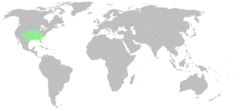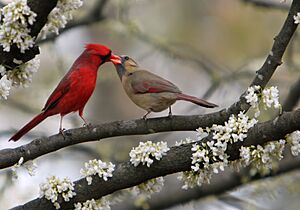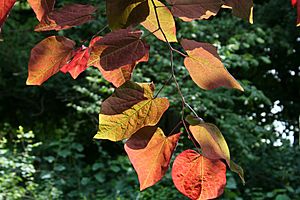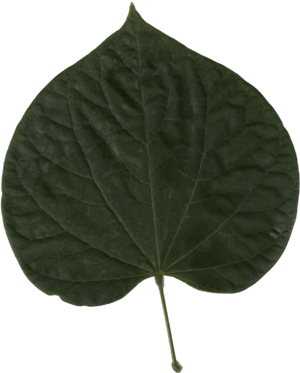Eastern redbud facts for kids
Quick facts for kids Eastern Redbud |
|
|---|---|
 |
|
| Eastern Redbud (Cercis canadensis) in Gettysburg National Military Park ). | |
| Conservation status | |
| Scientific classification | |
| Kingdom: | |
| Division: | |
| Class: | |
| Order: | |
| Family: | |
| Subfamily: | |
| Tribe: |
Cercideae
|
| Genus: |
Cercis
|
| Species: |
C. canadensis
|
| Binomial name | |
| Cercis canadensis |
|
 |
|
| natural range | |
The Cercis canadensis, also known as the Eastern Redbud, is a beautiful small tree or large shrub. It grows naturally across eastern North America. You can find it from southern Ontario, Canada, all the way south to northern Florida, United States. This tree is so special that it's even the state tree of Oklahoma!
Contents
What Does It Look Like?


The Eastern Redbud usually grows about 6 to 9 meters (20 to 30 feet) tall. Its branches can spread out 8 to 10 meters (25 to 33 feet) wide. Young trees, around 10 years old, are typically about 5 meters (16 feet) tall. The tree often has a short, twisted trunk and branches that spread wide.
Its bark is dark and becomes scaly as the tree gets older. The small branches are thin and zigzag-shaped, almost black, with lighter spots. The winter buds are tiny, round, and dark red.
The leaves are shaped like a heart and are thin and papery. They are smooth and dark green on top, and a bit lighter underneath. In autumn, these leaves turn a bright, clear yellow color.
Flowers and Fruit
The flowers are very pretty and bright, ranging from light to dark pink or magenta. They appear in clusters in spring and early summer, even before the leaves grow! Sometimes, you can even see flowers growing right on the tree's trunk.
Long-tongued bees, like blueberry bees and carpenter bees, help pollinate the flowers. This means they help the flowers make seeds.
After the flowers, the tree grows flat, dry, brown pods that look like peas. These pods hold flat, oval, brown seeds. The seeds are ready between August and October.
Where It Grows and Special Uses
In the wild, the Eastern Redbud often grows as a smaller tree under taller trees in forests. It's also a very popular ornamental tree planted in gardens and parks because of its beautiful flowers.
Some people in the southern Appalachian mountains use the green twigs of the Eastern Redbud to season wild game, like deer meat. Because of this, some people call it the "spicewood tree."
The leaves of the redbud tree are also a food source for some caterpillars, like the Io moth caterpillar.
This tree does not grow well in very dry areas, like western Kansas and Colorado, because it needs enough rain. It grows best in the lower Midwest and Ohio Valley regions. There's even a special type called the "Columbus Strain" that grows well in Columbus, Wisconsin.
Growing Redbuds
Many people plant C. canadensis in their parks and gardens. There are different types, called cultivars, that have been developed. One popular type is 'Forest Pansy', which has beautiful purple leaves. This cultivar has even won an award called the Royal Horticultural Society's Award of Garden Merit.
Can You Eat It?
Yes, you can! Native Americans used to eat redbud flowers raw or boiled. They also ate the roasted seeds. Scientists have studied the Eastern Redbud and found some interesting things about its edible parts:
- The flowers contain special colorful compounds called anthocyanins.
- Young green seeds have a compound called proanthocyanidin.
- The seeds also contain healthy fats like linolenic, alpha-linolenic, oleic, and palmitic acids.
Images for kids
See also
 In Spanish: Amor del Canadá para niños
In Spanish: Amor del Canadá para niños






